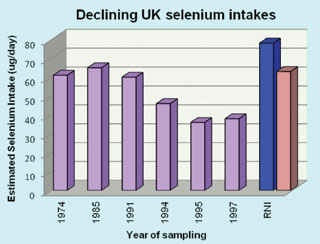Dietary Selenium and Cardiovascular Health
Published on 20 October 2010 in Food, health and wellbeing

Introduction
Selenium is a dietary micronutrient essential for maintaining optimal health in both animals and humans. It has been known that selenium levels are low in UK/European soils for a long time. Indeed, most of the reason for the falling selenium intakes within the UK in the last decades has been found to be due to a reduction in use of imported US wheat (with relatively high selenium levels) in favour of UK/European-sourced wheat which is relatively selenium poor. This issue has been highlighted recently by a Food Standards Agency report into selenium levels in Scottish soil and food products (published December 2009, Project Code S1 4042).
The role of selenium in health is most likely due to its presence in selenoproteins. Many of these selenoproteins are enzymes which protect against oxidative damage. Lower dietary selenium intakes may be associated with lowered protection from oxidant damage and increased risk of chronic diseases associated with oxidative stress such as cancer and cardiovascular disease.
Coronary heart disease (CHD) is a major cause of premature death worldwide with Scotland having one of the highest incidences in the developed world. A key objective of our research is to provide information that may help prevent or delay the onset of CHD and associated premature mortality. As inappropriate diet may account for up to 30-40% of all CHD, approaches to improve diet are therefore important to decrease the risk of heart disease within the population. However, more work is needed to provide greater understanding of the mechanisms involved through which specific nutrients or dietary regimes can prevent or delay the onset of the disease.
Key Points
- Dietary selenium intakes within Scotland have declined and current intakes are now considered marginal for optimal health and may increase risk of diseases such as CHD.
- The increasing interest in public procurement and consumption of locally produced foodstuffs (Scotland’s National Food and Drink Policy) may impact further on the selenium status of the Scottish population due to the inherent low selenium levels in Scottish soils.
- Polyunsaturated fatty acids have been shown to counter the effects of ‘bad’ fatty acids in CHD and promote health; selenium can potentially modify the effects of the different dietary fatty acids.
- Selenium exists in a number of different forms within the diet and in over-the-counter supplements and the different forms can differ in their effects within the body.
- More research is needed to determine the role of selenium and the different selenium forms in maintaining health and cardiovascular function and to identify how selenium interacts with fatty acids to influence the development of heart disease.
- A sound scientific evidence base is needed before appropriate advice can be given on how best to optimise selenium levels to maintain health within the Scottish population.
Research Undertaken
Recent studies exploring the molecular mechanisms thought to play a part in heart disease development have provided advances on the ways in which diet and dietary components can impact on the risk of heart disease. However, although dietary selenium has been proposed to protect against cardiovascular disease this area is controversial and its mechanism of action remains unclear.
We aim to understand how dietary selenium can influence the process of heart disease and delineate the mechanisms involved. Recently, we have shown within a model system of heart disease that maintaining an optimum dietary selenium intake can reduce heart disease whereas consuming a diet lacking selenium can increase heart disease. Furthermore, these effects correlate with the levels of ‘bad’ fatty acids within the bloodstream.
In addition, results have shown that selenium has anti-inflammatory effects both within immune cells and within endothelial cells (which line the inside of blood vessels) and that it can reduce the interaction between these cell types, which is an important early step in the development of heart disease.
Current work is addressing the roles played by the different chemical forms of selenium in relation to heart disease prevention. This work will provide an insight into the potential function played by the different selenium forms in the development of heart disease and determine which is more beneficial and at what level in combating heart disease.
Graph highlighting the declining selenium intakes within the UK population

Policy Implications
The increasing interest in public procurement and consumption of locally produced foodstuffs (Scotland’s National Food and Drink Policy) may impact further on the selenium status of the Scottish population due to the inherent low selenium levels in Scottish soils.
Author
Dr. Alan Sneddon A.Sneddon@abdn.ac.uk







